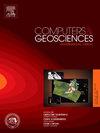双散射弹性最小二乘逆时偏移
IF 4.4
2区 地球科学
Q1 COMPUTER SCIENCE, INTERDISCIPLINARY APPLICATIONS
引用次数: 0
摘要
弹性最小二乘逆时偏移(ELSRTM)可以提高成像分辨率和解释多分量地震资料。然而,传统的ELSRTM只考虑一次散射波,不能考虑观测记录中的二次散射波。这一限制导致在有二次散射波存在的陡峭倾斜和复杂结构中成像不足。为了解决这个问题,我们提出了双散射弹性最小二乘逆时偏移(DS-ELSRTM)。在二阶Born近似下构造DS-ELSRTM的目标函数,推导其梯度,形成相应的计算算法和实现步骤。此外,我们还引入了改进的DS-ELSRTM策略,以解决DS-ELSRTM非线性过程中产生的二次散射波弱振幅匹配和非平稳梯度问题。通过将DS-ELSRTM和常规ELSRTM的成像结果与垂直断层模型和Marmousi模型进行数值实验对比,证明DS-ELSRTM方法在陡倾构造和复杂地质构造成像方面具有优势。DS-ELSRTM可以产生比传统ELSRTM更高精度的图像。本文章由计算机程序翻译,如有差异,请以英文原文为准。
Dual-scattering elastic least-squares reverse time migration
Elastic least-squares reverse time migration (ELSRTM) can enhance imaging resolution and interpret multicomponent seismic data. However, traditional ELSRTM only considers primary scattered waves and cannot accommodate secondary scattered waves in the observed records. This limitation leads to inadequate imaging of steeply dipping and complex structures, where secondary scattered waves are present. To address this issue, we propose dual-scattering elastic least-squares reverse time migration (DS-ELSRTM). We construct the objective function of DS-ELSRTM under the second-order Born approximation and derive its gradient, forming a corresponding computational algorithm and implementation steps. Additionally, we introduce improved DS-ELSRTM strategies to address the weak amplitude matching of secondary scattered waves and the non-stationary gradient issue that arises during the nonlinear process of DS-ELSRTM. By comparing the imaging results of DS-ELSRTM and conventional ELSRTM in numerical experiments with the vertical fault model and Marmousi model, it is demonstrated that the DS-ELSRTM method has advantages in imaging steeply dipping structures and complex geological structures. DS-ELSRTM can produce higher-precision images than conventional ELSRTM.
求助全文
通过发布文献求助,成功后即可免费获取论文全文。
去求助
来源期刊

Computers & Geosciences
地学-地球科学综合
CiteScore
9.30
自引率
6.80%
发文量
164
审稿时长
3.4 months
期刊介绍:
Computers & Geosciences publishes high impact, original research at the interface between Computer Sciences and Geosciences. Publications should apply modern computer science paradigms, whether computational or informatics-based, to address problems in the geosciences.
 求助内容:
求助内容: 应助结果提醒方式:
应助结果提醒方式:


